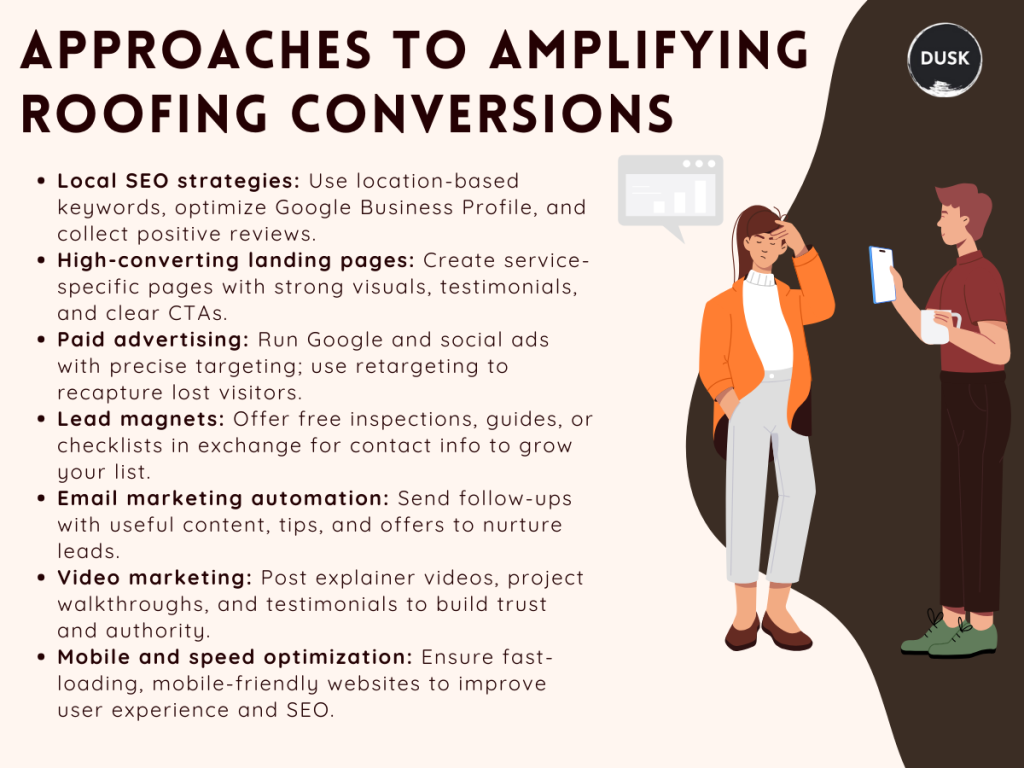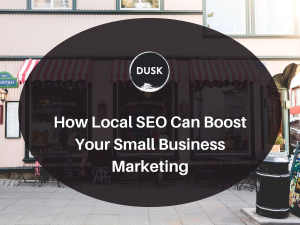In today’s digital age, a professional roofing website is more than just a digital presence; it’s a powerful tool for driving leads and growing your business. A well-designed site not only showcases your expertise and services but also provides potential customers with a seamless experience, fostering trust and credibility.
By incorporating essential features like clear navigation, compelling content, and easy contact options, you can effectively capture and convert visitors into valued clients. This strategic approach can significantly boost your online visibility and help you stand out in a competitive market.
Core Elements of a Lead-Generating Roofing Website
A well-designed website is essential for any roofing company looking to attract and convert potential customers. If your site isn’t optimized for lead generation, you’re missing out on valuable business. Here are five core elements every roofing website should have to generate more leads.
1. A Clear and Compelling Call-to-Action (CTA)
Your website should guide visitors toward taking action. Whether it’s scheduling an inspection, requesting a quote, or calling your team, a strong CTA is crucial. Make sure your CTA stands out with contrasting colors, clear wording, and strategic placement. Phrases like “Get a Free Estimate Today” or “Schedule Your Roof Inspection Now” encourage users to take the next step.
2. Mobile-Friendly and Fast-Loading Design
Most users will visit your site from their mobile devices, so it must be optimized for them. A slow, clunky website will drive potential customers away. Ensure your site loads quickly, has easy navigation, and is fully responsive. Google prioritizes mobile-friendly websites, so optimizing for speed and usability also improves your search rankings.
3. High-Quality and Informative Content
Providing valuable content builds trust with potential customers. Your blog should cover roofing FAQs, maintenance tips, and project showcases. Answering common questions like “How much does a roof replacement cost?” or “What are the best roofing materials?” helps establish your expertise while improving your website’s SEO.
4. Strong Visuals and Customer Testimonials
Images and reviews help build credibility and influence customer decisions. Include high-quality images of completed roofing projects, before-and-after transformations, and team photos. Positive testimonials from satisfied customers add social proof and reassure potential clients that they are making the right choice.
5. Easy Contact Options
Make it simple for potential customers to reach you. Your phone number, email, and contact form should be easy to find on every page. Live chat options can also help capture leads instantly. The easier it is for visitors to get in touch, the more likely they are to convert into paying customers.
Advanced Tactics to Amplify Lead Generation
A basic website is not enough to attract and convert leads in today’s competitive roofing industry. To stand out, you need to use advanced strategies that turn visitors into paying customers. Here are some powerful tactics to amplify your lead-generation efforts.

1. Implement Local SEO Strategies
Ranking high in local search results makes it easier for potential customers to find your roofing business. Optimize your website with location-based keywords like “roofing contractor in [Your City].”
Claim and optimize your Google Business Profile to appear in local search and Google Maps. Encourage satisfied customers to leave reviews, as positive ratings boost your credibility and rankings.
2. Use High-Converting Landing Pages
A well-optimized landing page can significantly increase conversions. Instead of directing all traffic to your homepage, create dedicated landing pages for specific services like roof repair, replacements, or inspections. Include compelling headlines, strong visuals, customer testimonials, and a clear call-to-action (CTA) to encourage visitors to take action.
3. Leverage Paid Advertising (PPC & Social Media Ads)
Investing in paid ads can quickly boost website traffic and lead generation. Google Ads and Facebook Ads allow you to target homeowners who are actively searching for roofing services. Use precise targeting options like location, interests, and demographics to reach the right audience. Retargeting ads can also bring back visitors who didn’t convert the first time.
4. Offer Valuable Lead Magnets
Providing free resources in exchange for contact information helps capture potential leads. Offer a free roofing inspection, an eBook on “How to Maintain Your Roof,” or a downloadable checklist for storm damage assessment. These lead magnets position your business as an authority and help build your email list for future marketing efforts.
5. Automate Follow-Ups with Email Marketing
Email marketing keeps your business top-of-mind for potential customers. Set up automated email sequences to follow up with leads who request quotes or visit your site. Share useful content, seasonal maintenance tips, and exclusive offers to nurture leads and move them toward booking your services.
6. Utilize Video Marketing
Videos are an engaging way to build trust and showcase your expertise. Create short explainer videos on common roofing problems, project walkthroughs, and customer testimonials. Share these on your website, YouTube, and social media to attract and educate potential clients.
7. Optimize for Mobile and Speed
A slow or unresponsive website will drive potential customers away. Ensure your site loads quickly and is mobile-friendly. Google prioritizes fast-loading, mobile-optimized sites, which improves your search rankings and user experience.
Measuring Success and Optimization
Creating a lead-generating roofing website is just the first step. To ensure long-term success, you need to measure its performance and optimize it for better results. Tracking key metrics allows you to identify what’s working and what needs improvement. Here’s how you can measure success and fine-tune your website for maximum lead generation.
1. Track Website Traffic and Engagement
Understanding how visitors interact with your website is crucial for making informed improvements. Use tools like Google Analytics to monitor website traffic, bounce rates, and page views. Pay attention to which pages attract the most visitors and how long they stay on your site. If users are leaving quickly, it may indicate issues with content, navigation, or site speed.
2. Monitor Conversion Rates
Your website’s ability to turn visitors into leads is the ultimate measure of success. Track conversion rates for key actions such as contact form submissions, phone calls, and quote requests. If you have a high number of visitors but a low conversion rate, consider optimizing your call-to-action (CTA), simplifying your contact forms, or improving landing page design.
3. Evaluate SEO Performance
Ranking higher in search engine results means more potential customers can find you. Regularly check your website’s keyword rankings and organic traffic. Use tools like Google Search Console to see which search queries bring people to your site. If your rankings are low, improve your on-page SEO by adding relevant keywords, optimizing meta descriptions, and ensuring your content is valuable and engaging.
4. Assess Lead Quality and Sources
Not all leads are created equal—focus on attracting high-quality prospects. Track where your leads are coming from—whether it’s organic search, social media, paid ads, or referrals. If certain channels generate more valuable leads than others, allocate more resources to those areas. Analyzing lead quality helps you refine your marketing strategy and invest in the most effective tactics.
5. Optimize for User Experience (UX)
A user-friendly website keeps visitors engaged and increases conversions. If users struggle with navigation, slow loading times, or unresponsive pages, they’ll likely leave. Conduct regular website audits to ensure fast load speeds, mobile compatibility, and intuitive design. A well-optimized site creates a seamless experience that encourages visitors to take action.
6. Leverage A/B Testing
Small changes can make a big impact on lead generation. Run A/B tests on different website elements, such as CTA buttons, headlines, or landing page layouts, to see what drives the most engagement. Testing helps you refine your website for better performance and higher conversion rates.
7. Use Heatmaps to Understand User Behavior
Heatmaps provide visual insights into how visitors interact with your site. Tools like Hotjar or Crazy Egg show where users click, scroll and spend the most time. This data helps you identify which elements attract attention and which may need adjustment. If users ignore your CTA or struggle to find key information, repositioning or redesigning those sections can improve engagement.
8. Improve Content Based on Analytics
Content plays a key role in lead generation, so it should be continuously improved. Review which blog posts, service pages, and FAQs get the most traffic and engagement. Update older content with fresh information and optimize it for SEO. If certain topics perform well, create more content around those areas to attract and convert more visitors.
6 Reasons Why Your Company Needs A Good Website
A professional roofing website is a powerful tool for driving leads and growing your business. By incorporating elements like mobile-friendliness, high-quality visuals, and clear calls to action, you can convert visitors into potential clients.
A well-designed site not only enhances your brand’s credibility but also serves as a digital storefront, guiding customers to your services. By investing in a robust online presence, you can significantly boost traffic and secure more roofing jobs, ultimately expanding your customer base and increasing revenue.






